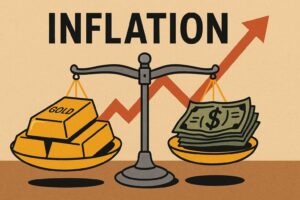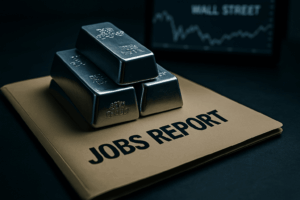Every second, somewhere in the world, gold is trading. The gold spot price represents the current market value of one troy ounce of pure gold for immediate delivery. It’s not a retail quote or an investment recommendation — it’s the foundation price that influences everything from central bank reserves to the coins and bars investors buy.
Unlike the price you see at a coin shop (which includes premiums for fabrication and distribution), the spot price reflects wholesale value — the institutional price determined by continuous trading across major exchanges such as the London Bullion Market Association (LBMA) and COMEX.
How the Gold Spot Price Is Determined
The spot price of gold is a living number, constantly adjusting to the global flow of money, risk, and sentiment. It’s driven by a mix of powerful forces:
- Currency movements: Because gold is priced in U.S. dollars, a weaker dollar usually supports higher gold prices.
- Interest rates and inflation: Rising inflation or falling real yields often make gold more attractive as a store of value.
- Geopolitical tension: Conflict, sanctions, or financial instability push investors toward safe havens like gold.
- Physical demand: Central banks, jewelry markets, and private investors all shape long-term price trends.
In short, the gold spot price is not an opinion — it’s a reflection of global confidence.
Why the Spot Price Matters
For investors, the gold spot price offers transparency and accountability. It anchors the value of your holdings and provides a benchmark to evaluate premiums or discounts when buying or selling.
It also connects gold’s day-to-day movements with the broader economy. When you see the spot price rising, it often signals uncertainty in other asset classes — bonds, equities, or currencies. When it falls, it may indicate temporary confidence in riskier assets.
But here’s the key point: spot price isn’t a signal to trade — it’s a signal to understand.
Spot Price vs. Market Price: The Difference That Matters
The spot price serves as the benchmark for large institutional trades in the wholesale market. Actual transactions typically occur slightly above or below that level, depending on volume, form, and settlement terms. The market price, by contrast, includes premiums — costs added for fabrication, logistics, and dealer margins.
That’s why you’ll always pay more than the spot price when buying physical gold, and why physical coins or bars can retain or even increase value during supply shortages — even if the spot price is flat.
Premiums are also a powerful indicator of real-world demand. When premiums rise, it’s often a sign that physical demand is outpacing paper supply — a dynamic not always visible in the spot price itself.
Why Long-Term Investors Should Focus Beyond Daily Fluctuations
Trying to time gold purchases based on small spot price changes is like predicting the wind. What matters more is why gold holds its value over time.
Gold’s role isn’t speculation — it’s stabilization. It’s a store of purchasing power that transcends political cycles, interest rate decisions, and even currencies. The spot price simply tracks that store of value day by day, offering a real-time lens into a world that’s constantly changing.
Long-term investors use it as a reference, not a trigger — buying consistently, averaging in over time, and viewing gold as a permanent foundation of their portfolio.
The Takeaway: Know the Price, But Understand Its Purpose
The gold spot price offers a real-time reflection of investor confidence and monetary stability — not a crystal ball for market timing. It reflects trust, risk, and the flow of money in real time. Understanding it helps investors make informed, disciplined decisions that align with their long-term goals.
At GoldSilver, we believe financial education should always come before transactions. Because when you understand how gold’s value is set — and why it endures — you don’t chase the price.
You own the certainty behind it.
People Also Ask
What is the gold spot price?
The gold spot price is the current market value for one troy ounce of pure gold, quoted for immediate delivery. It reflects global trading activity on exchanges like the LBMA and COMEX and serves as a benchmark for pricing coins, bars, and bullion products. You can view live spot prices and insights anytime at GoldSilver.
How is the gold spot price determined?
The gold spot price is determined by continuous buying and selling across global exchanges, influenced by supply and demand, currency strength, interest rates, and investor sentiment. It changes 24 hours a day as markets react to economic and geopolitical news.
Why does the gold spot price change so often?
Gold trades nearly around the clock across time zones, so its price constantly adjusts to new data, economic reports, and global events. Factors like inflation expectations, central bank policy, and currency fluctuations cause minute-by-minute movements in the spot price.
Is the spot price the same as what I pay for physical gold?
Not exactly. The spot price is a wholesale benchmark, while the market price you pay for physical coins or bars includes a small premium for fabrication, distribution, and dealer costs. Visit GoldSilver to compare real-time spot prices with live retail pricing.
Can investors buy gold at the spot price?
In practice, no — even large institutional trades occur slightly above or below the quoted spot price depending on volume, settlement, and delivery terms. For individual investors, premiums reflect the true cost of owning and storing physical metal securely.
Get Gold & Silver Insights Direct to Your Inbox
Join thousands of smart investors who receive expert analysis, market updates, and exclusive deals every week.









